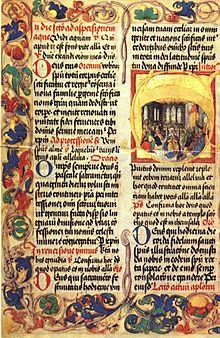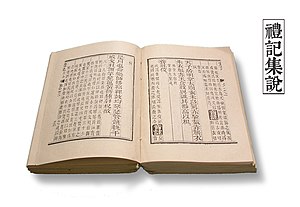Rubric


A rubric is a word or section of text that is traditionally written or printed in
Rubric can also mean the red ink or paint used to make rubrics, or the pigment used to make it.[2] Although red was most often used, other colours came into use from the late Middle Ages onwards, and the word rubric was used for these also. Medievalists can use patterns of rubrication to help identify textual traditions.[3]
Various figurative senses of the word have been extended from its original meaning. Usually these senses are used within the set phrase "under [whatever] rubric", for example, "under this rubric, [X is true]", or "[X was done] under the rubric of Y". Such senses include: "an authoritative rule";[4] "the title of a statute";[4] "something under which a thing is classed";[4] "an explanatory or introductory commentary";[4] "an established rule, tradition, or custom";[4] or "a guide listing specific criteria for grading or scoring academic assignments".[4]
As liturgical instructions
Instructions for a priest explaining what he must do during a
After the development of printing

With the arrival of printing, other typographic effects such as italic type, bolded type, or different sizes of type were used to emphasize a section of text, and as printing in two colours is more expensive and time consuming, rubrication has tended to be reserved for sacred and liturgical books or luxury editions of other works.
William Morris's medievally inspired typography for the Kelmscott Press at the end of the 19th century included chapter titles and other accents in red, or rarely blue, ink, and was influential on small press art typography associated with the Arts and Crafts movement in both England and the United States, particularly the work of the Ashendene, Doves, and Roycroft Presses.[8][9]
Around 1900,
Rubrics in education
A rubric is an explicit set of criteria used for assessing a particular type of work or performance and provides more details than a single grade or mark. Rubrics, therefore, help teachers grade more objectively and "they improve students' ability to include required elements of an assignment".[10]
See also
References
- OEDmeaning 1a.
- ^ OED meaning 1b
- ISBN 90-04-18464-3.
- ^ a b c d e f Merriam-Webster (11 March 2024), "headword "rubric"", Merriam-Webster's Collegiate Dictionary (11th ed.), Merriam-Webster.
- ^ "Rubrics". Catholic Encyclopedia.
- ^ OED meaning 3.
- ^ Catholic Encyclopedia, article cited.
- ^ ISBN 0-8109-4282-8.
- ISBN 0-500-28434-2, p. 122–124.
- ^ "Rubrics for Assessment - NIU - Center for Innovative Teaching and Learning". Northern Illinois University. Retrieved 2021-09-27.
- Glossary of Manuscript Terms Archived 2008-01-15 at the Wayback Machine British Library
External links
- . Encyclopædia Britannica. Vol. 23 (11th ed.). 1911. p. 810.
- Rubrics of the Anglican Low Mass (from 1931) Archived 2008-05-23 at the Wayback Machine Very full set of rubrics (more than a normal service book would include); perversely, the words to be spoken are here shown in red, and the rubrics in black.
- Catholic Order of Mass Archived 2011-07-02 at the Wayback Machine Rubrics showing who speaks are in red; others in small italics.
- Kelmscott Press Examples of Kelmscott Press pages showing use of red accents.
- So this then is the preachment entitled Chicago tongue Archived 2008-11-21 at the Wayback Machine A "flip book" presentation of the Roycroft Press edition c. 1913, illustrating use of rubrics in the Arts and Crafts tradition.
- Good Recipes Archived 2008-11-22 at the Wayback Machine This cookbook published by the Woman's Society of the Winnetka Congregational Church in 1906 shows the influence of Arts and Crafts rubrics on everyday typography in the early 20th century.

